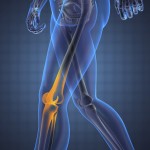 Osteoarthritis (OA) is one of the most common causes of disability in America, and obesity is one of its most important risk factors for weight-bearing joint involvement. A new study in today s JAMA, compared the benefits of intensive diet-induced weight loss, with or without exercise, on OA symptom severity.
Osteoarthritis (OA) is one of the most common causes of disability in America, and obesity is one of its most important risk factors for weight-bearing joint involvement. A new study in today s JAMA, compared the benefits of intensive diet-induced weight loss, with or without exercise, on OA symptom severity.
The goal was to reduce weight by at least 10 percent with diet. Then, in a single-blind prospective fashion over an 18-month period, to study the effects on OA by such weight loss from diet, and compare OA symptom changes to a similar diet-induced weight loss plus exercise. A third group was put on exercise alone. The lead researcher was Stephen P. Messier, PhD, of Wake Forest University, NC. The study subjects were 454 older overweight or obese adults (age over 55), of whom 399 completed the study (no mention was made of the male-female ration).
Comparing single strategies, diet came out better than exercise for reducing knee joint loading and cutting inflammation. Joint inflammation, pain, function, and quality of life all significantly favored the combined approach diet-induced weight loss plus exercise compared with exercise alone over 18 months.
ACSH s Dr. Gilbert Ross had this comment: The knee joint deterioration of OA is well-known to be accelerated by obesity. Any weight loss you can persuade an arthritic patient to accomplish will almost certainly improve his or her symptoms without increasing the amount of pain medicine required, so that s a big plus. However, actually getting a patient to lose weight is easier said than done. And while it s undeniable that some exercise is beneficial, both for the joints and the cardiovascular system, the doctor must also get the pain and stiffness under some control to allow the exercise to occur, so a go slow but steady approach is best along with appropriate pain relief medication.


